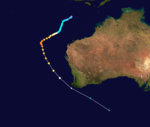1977–78 Australian region cyclone season
| 1977–78 Australian region cyclone season |

Season summary map
|
| Seasonal boundaries |
| First system formed |
6 November 1977 |
| Last system dissipated |
11 April 1978 |
| Strongest storm |
|
| Name |
Alby |
| • Maximum winds |
205 km/h (125 mph)
(10-minute sustained) |
| • Lowest pressure |
930 hPa (mbar) |
|
| Seasonal statistics |
| Tropical lows |
9 |
| Tropical cyclones |
5 |
| Severe tropical cyclones |
2 |
| Total fatalities |
Unknown |
| Total damage |
Unknown |
| Related articles |
|
|
Australian region tropical cyclone seasons
1975–76, 1976–77, 1977–78, 1978–79, 1979–80
|
|
|
| Duration |
6 November – 11 November |
| Peak intensity |
Winds not specified 990 hPa (mbar) |
| Tropical low (Australian scale) |
|
|
| Duration |
13 December – 14 December (exited basin) |
| Peak intensity |
45 km/h (30 mph) (10-min) 1003 hPa (mbar) |
| Category 2 tropical cyclone (SSHWS) |
|
|
| Duration |
10 January – 20 January |
| Peak intensity |
175 km/h (110 mph) (1-min) 954 hPa (mbar) |
| Category 1 tropical cyclone (SSHWS) |
|
|
| Duration |
27 January – 3 February |
| Peak intensity |
150 km/h (90 mph) (1-min) 964 hPa (mbar) |
| Tropical storm (SSHWS) |
|
|
| Duration |
25 February – 27 February |
| Peak intensity |
95 km/h (60 mph) (1-min) 987 hPa (mbar) |
| Category 3 tropical cyclone (SSHWS) |
|
|
| Duration |
16 March – 29 March |
| Peak intensity |
205 km/h (125 mph) (1-min) 945 hPa (mbar) |
| Category 5 severe tropical cyclone (Australian scale) |
| Category 4 tropical cyclone (SSHWS) |
|
|
| Duration |
27 March – 5 April |
| Peak intensity |
205 km/h (125 mph) (10-min) 930 hPa (mbar) |
| Tropical storm (SSHWS) |
|
|
| Duration |
5 April – 14 April |
| Peak intensity |
95 km/h (60 mph) (1-min) 990 hPa (mbar) |
| Category 5 severe tropical cyclone (Australian scale) |
| Category 4 tropical cyclone (SSHWS) |
|
|
| Duration |
6 April – 11 April |
| Peak intensity |
240 km/h (150 mph) (10-min) 985 hPa (mbar) |
The 1977–78 Australian region cyclone season was a below average tropical cyclone season.
On 27 March, a tropical depression developed in the eastern Indian Ocean between Indonesia and Australia. It drifted to the southwest, and slowly strengthened into a tropical storm on 29 March. Alby continued slowly southwestward, and attained cyclone status on 30 March. The rate of intensification, which was slower earlier in its life, became more steady towards strengthening, and reached the equivalent of Category 3 status on 1 April. Tropical Cyclone Alby turned more to the south, and quickly reached a peak of 135 mph (217 km/h) later on 1 April. After maintaining its strength for 30 hours, Alby weakened as it turned to the southeast. Its forward momentum increased over the southeast Indian Ocean, and Alby was only an 85 mph (137 km/h) cyclone as it passed off the southwest coast of Australia on 4 April. It continued rapidly to the southeast, and became extra-tropical on 5 April while south of the continent.
On 4 April, Tropical Cyclone Alby passed close to the southwest corner of Western Australia, killing five people and causing widespread but mostly minor damage to the southwest. The damage bill was estimated to be $39 million (2003 dollars). A man was blown from the roof of a shed and a woman was killed by a falling pine tree. Another man was killed when a tree fell on the bulldozer he was operating and two men drowned when their dinghy overturned at Albany. Storm surge and destructive waves caused coastal inundation and erosion from Perth to Busselton, damaging the Busselton Jetty and Fremantle Harbour. Fires fanned by the strong winds burned an estimated 1,140 km2 (440 sq mi) of forest and farming land.
...
Wikipedia












